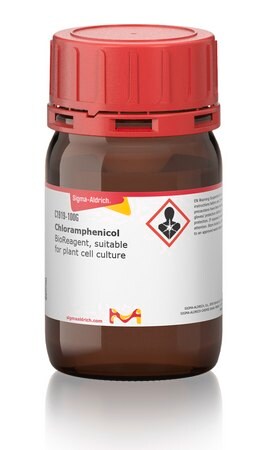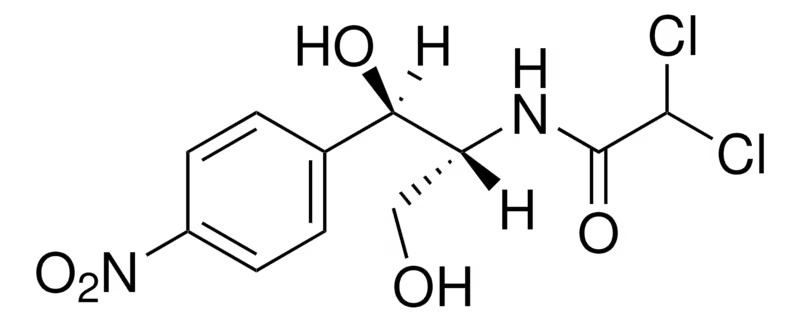Sigma-Aldrich Chloramphenicol, BioReagent, suitable for plant cell culture
Catalog No :
CAS Number :
Brand :
In Stock
Specifications:
| Application | Cell culture | ||
| Storage Temperature | 2-8°C | ||
| Product Type | Antibiotic | Forms | Powder |
| Product Brand | Sigma-Aldrich | ||
| Product Grade | Cell Culture | Formula | C₄₃H₅₈N₄O₁₂ |
Broad-Spectrum Antibiotic for Microbiology, Molecular Biology, and Plant Tissue Culture
Sigma-Aldrich Chloramphenicol (BioReagent, Cell Culture Grade) is a high-purity, broad-spectrum antibiotic widely used in plant cell culture, molecular biology, and microbiology research. It is a synthetic antibiotic originally derived from Streptomyces venezuelae and is effective against Gram-positive, Gram-negative bacteria, mycoplasma, and certain mycobacteria.
With its high stability, endotoxin-tested purity, and ability to inhibit bacterial protein synthesis, Chloramphenicol is widely used in molecular biology applications for bacterial selection (10–20 µg/mL) and as a selection agent for transformed plant cells containing chloramphenicol resistance genes.
Key Features & Benefits
✅ High-Purity BioReagent Grade – Ensures consistent and reproducible results in cell culture and microbiology applications
✅ Broad-Spectrum Antibiotic – Effective against Gram-positive & Gram-negative bacteria, mycoplasma, and mycobacteria
✅ Validated for Plant Cell Culture & Bacterial Selection – Suitable for genetic transformation and antibiotic resistance studies
✅ Mode of Action: Protein Synthesis Inhibitor – Blocks peptidyl transferase activity in the 50S ribosomal subunit
✅ Endotoxin-Tested & Highly Stable – Maintains potency over a wide pH range and in aqueous solutions
✅ Long-Term Storage Stability – Retains activity at 2–8°C, with aqueous solutions stable for months
✅ Compatible with Molecular Biology & Genetic Engineering – Used in plasmid selection, recombinant protein expression, and gene cloning
Technical Specifications
| Attribute | Details |
|---|---|
| Product Name | Chloramphenicol |
| Product Line | BioReagent |
| Chemical Formula | Cl₂CHCONHCH(CH₂OH)CH(OH)C₆H₄NO₂ |
| Molecular Weight | 323.13 g/mol |
| CAS Number | 56-75-7 |
| Purity | ≥95% (HPLC) |
| Form | Powder |
| Color | White to Off-White |
| Melting Point | 149–153°C |
| Storage Conditions | 2–8°C (Light Sensitive) |
| Antibiotic Spectrum | Gram-positive, Gram-negative, Mycoplasma, Mycobacteria |
| Mode of Action | Inhibits protein synthesis by binding to 50S ribosomal subunit |
| Solubility | Ethanol, DMSO, Slightly Soluble in Water |
| Regulatory Compliance | Research Use Only (RUO) |
Mechanism of Action & Resistance
Mode of Action:
- Chloramphenicol inhibits bacterial protein synthesis by binding to the 50S ribosomal subunit, blocking peptidyl transferase activity.
- This prevents amino acid chain elongation, leading to cell growth inhibition and bacterial death.
- It also inhibits mitochondrial and chloroplast protein synthesis, making it effective for plant cell culture studies.
Mode of Resistance:
- Bacteria expressing chloramphenicol acetyltransferase (CAT) can acetylate and inactivate chloramphenicol.
- Resistance is typically plasmid-mediated and may involve efflux pumps reducing intracellular antibiotic concentrations.
Antimicrobial Spectrum:
✔ Gram-Positive Bacteria (Staphylococcus spp., Streptococcus spp.)
✔ Gram-Negative Bacteria (Escherichia coli, Salmonella spp., Klebsiella spp.)
✔ Mycoplasma & Mycobacteria
✔ Used in Veterinary Medicine & Ophthalmic Applications
Applications
🔬 Plant Cell Culture & Genetic Transformation – Used as a selection agent for transformed cells with chloramphenicol resistance genes
🦠 Microbial Pathogenesis & Antibiotic Resistance Studies – Supports bacterial inhibition research
⚗️ Molecular Biology & Cloning – Used in bacterial selection for plasmid maintenance (10–20 µg/mL)
🧪 Protein Expression & Recombinant DNA Technology – Ensures plasmid stability in E. coli cultures
🏭 Biopharmaceutical & Drug Development – Used in screening for new antibiotic formulations
Preparation & Storage Guidelines
1️⃣ Preparation of Stock Solution
- Dissolve 50 mg/mL in ethanol, methanol, or DMSO for best solubility.
- Aqueous solutions are neutral and stable over a wide pH range.
- Filter sterilization is recommended (do not autoclave).
2️⃣ Recommended Working Concentrations
- Bacterial Selection in Molecular Biology: 10–20 µg/mL
- Plant Cell Culture Transformation: 20–50 µg/mL
3️⃣ Storage Conditions
- Store at 2–8°C in a dry, well-ventilated place.
- Keep away from direct light to prevent degradation.
Ordering Information
| Pack Size | Catalog Number |
|---|---|
| 5 g | C1919-5G |
| 25 g | C1919-25G |
| 100 g | C1919-100G |
Regulatory & Safety Information
⚠️ For Research Use Only (RUO). Not intended for clinical or therapeutic applications.
⚠️ Light-Sensitive & Hygroscopic – Store in a dry, well-ventilated environment.
⚠️ Use Protective Equipment (PPE) – Avoid direct skin contact & inhalation during handling.
Why Choose Sigma-Aldrich Chloramphenicol (BioReagent, Cell Culture Grade)?
🔹 High-Purity BioReagent (≥95%) for Research Applications
🔹 Broad-Spectrum Antibiotic Effective Against Gram-Positive & Gram-Negative Bacteria
🔹 Validated for Plant Cell Culture & Bacterial Selection (10–20 µg/mL)
🔹 Long-Term Stability Under Controlled Storage Conditions
🔹 Available in Multiple Pack Sizes for Research Flexibility
For bulk orders, technical support, or additional information, contact LabMart Limited today. 🚀
- Pack Size: 100g 5g 25g




 0
0



